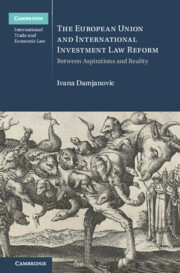Book contents
- The European Union and International Investment Law Reform
- Cambridge International Trade and Economic Law
- The European Union and International Investment Law Reform
- Copyright page
- Contents
- Figures
- Tables
- Foreword
- Acknowledgements
- Table of Cases
- Table of Legislation
- Abbreviations
- General Introduction
- Part I International Investment Regulation
- Part II The Internal Investment System of the EU
- Part III The External Investment System of the EU
- Introduction to Part III
- 7 Political Context of the EU International Investment Reform
- 8 EU Standards in International Investment Treaties
- 9 The Investment Court System
- 10 The EU and UNCITRAL
- Conclusion to Part III
- General Conclusion
- Bibliography
- Index
8 - EU Standards in International Investment Treaties
from Part III - The External Investment System of the EU
Published online by Cambridge University Press: 13 July 2023
- The European Union and International Investment Law Reform
- Cambridge International Trade and Economic Law
- The European Union and International Investment Law Reform
- Copyright page
- Contents
- Figures
- Tables
- Foreword
- Acknowledgements
- Table of Cases
- Table of Legislation
- Abbreviations
- General Introduction
- Part I International Investment Regulation
- Part II The Internal Investment System of the EU
- Part III The External Investment System of the EU
- Introduction to Part III
- 7 Political Context of the EU International Investment Reform
- 8 EU Standards in International Investment Treaties
- 9 The Investment Court System
- 10 The EU and UNCITRAL
- Conclusion to Part III
- General Conclusion
- Bibliography
- Index
Summary
With the foreign investment competence in the Lisbon Treaty, the EU has set an objective to develop a coherent international investment policy. This policy is now being implemented through EU (mixed) international investment agreements and the Member States’ extra-EU BITs concluded with third countries in the post-Lisbon period. Both set of agreements serve to replace or supplement the existing extensive network of pre-Lisbon extra-EU BITs of Member States. As a matter of principle, a coherent EU policy could ensure the same level of protection for all EU economic operators investing abroad, contributing to the uniformity of the Common Commercial Policy. Further, it supports the EU in the global reform of international investment governance. Ultimately, a coherent external approach of the EU and its Member States could improve consistency between the regulation of investment internally and externally, thus endorsing the EU vision of constitutionalism in international law. In this chapter we examine the extent to which the EU has achieved coherence between EU’s and Member States’ investment agreements. We analyse substantive and procedural provisions of pre- and post-Lisbon Member States’ extra-EU BITs and EU international investment agreements in light of primary EU law, the existing transitional arrangements in EU secondary law and the CJEU case-law.
Keywords
- Type
- Chapter
- Information
- The European Union and International Investment Law ReformBetween Aspirations and Reality, pp. 252 - 313Publisher: Cambridge University PressPrint publication year: 2023



